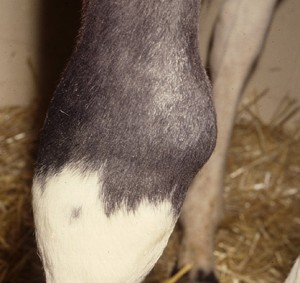Physitis in Young Horses
By: Heather Smith Thomas
When a foal is young and growing, lengthening of the leg bones occurs swiftly, due to changes and growth at the ends of those bones. The region of bone-growing activity is called the physis or growth plate. This is where new cartilage cells are formed and then replaced by bone. Growth plates at the ends of the cannon, distal radius, and distal tibia are instrumental in lengthening these bones as the foal grows larger and taller. Inflammation in the growth plates is called physitis.
Dr. Gary Baxter, Hospital Director at University of Georgia in Athens, says physitis is considered one of the growth problems/abnormalities in DOD (developmental orthopedic disease) in young horses. “We don’t always know the exact cause of physics. In many instances they enlarge for awhile; then the enlargement disappears as the foal matures. If there is no heat or pain, it may be a normal condition. Some enlargements are abnormal, however, and can be caused by improper nutrition or trauma, such as too much exercise and concussion on delicate growth plates,” he says.
“There may be times when the physis is more vulnerable to trauma. If the foal overuses the leg when the bone is still soft, there may be some crushing/damage to the cells in the growth plate. This could create signs of swelling and inflammation.”
The growth plate is most vulnerable during the first year of life and particularly when the foal is growing fastest—during the first six to nine months. “There can be a nutritional component and/or a mechanical component in physitis. There might be regions of trauma, such as subchondral bone damage or microfractures in that area, leading to clinical signs of inflammation,” Baxter explains.
“If only one physis is affected, we suspect mechanical or traumatic cause, whereas if multiple physes are involved (enlargements on all four distal cannon bones) it might be related to growth. The physes at the distal cannon bone close before the carpus and tarsus. In general, we see physitis involving the distal cannon in younger foals (knobby fetlock joints) and swelling at the knees and hocks in older foals.”
Mechanical physitis problems, especially at knees and fetlocks, can lead to crooked legs (angular limb deformity). The bone is growing faster on one side than the other, due to the inflammation more on one side—leading to asymmetrical bone growth.
“We tend to see more incidences of physitis in foals that are pushed for fast growth with diets high in protein and energy. It may help to back off on those feeds,” says Baxter. Young horses that are not overfed and allowed to grow more slowly and naturally seem less prone to significant physitis.
“If there is a lot of inflammation in the physis, yet the limb is still straight, it is important to limit the foal’s activity. If you allow the foal a lot of exercise, it may lead to trauma and damage on that inflamed area and softened bone. This could contribute to asymmetrical growth and angular limb deformities. If there is no heat or pain, and just some swelling, this is less worrisome,” he says.
“For the ones showing clinical signs, I suggest restricting the foal’s activity and trying to treat the inflammation—by using low dose NSAIDs (non-steroidal anti-inflammatory drugs) or topical NSAIDs (like Surpass). The latter can be applied to the swollen area rather than giving a systemic treatment. Rubbing it on the legs may be better than giving these drugs systemically (which can lead to GI problems),” he says.
Enlargements usually disappear as the foal grows, or may remain as knobby joints. Pay attention to foals as they grow, to know if they change from week to week. “Observe them frequently, because things can happen quickly in these babies. If there’s something that needs attention, it’s best to deal with it as soon as possible,” Baxter says.











